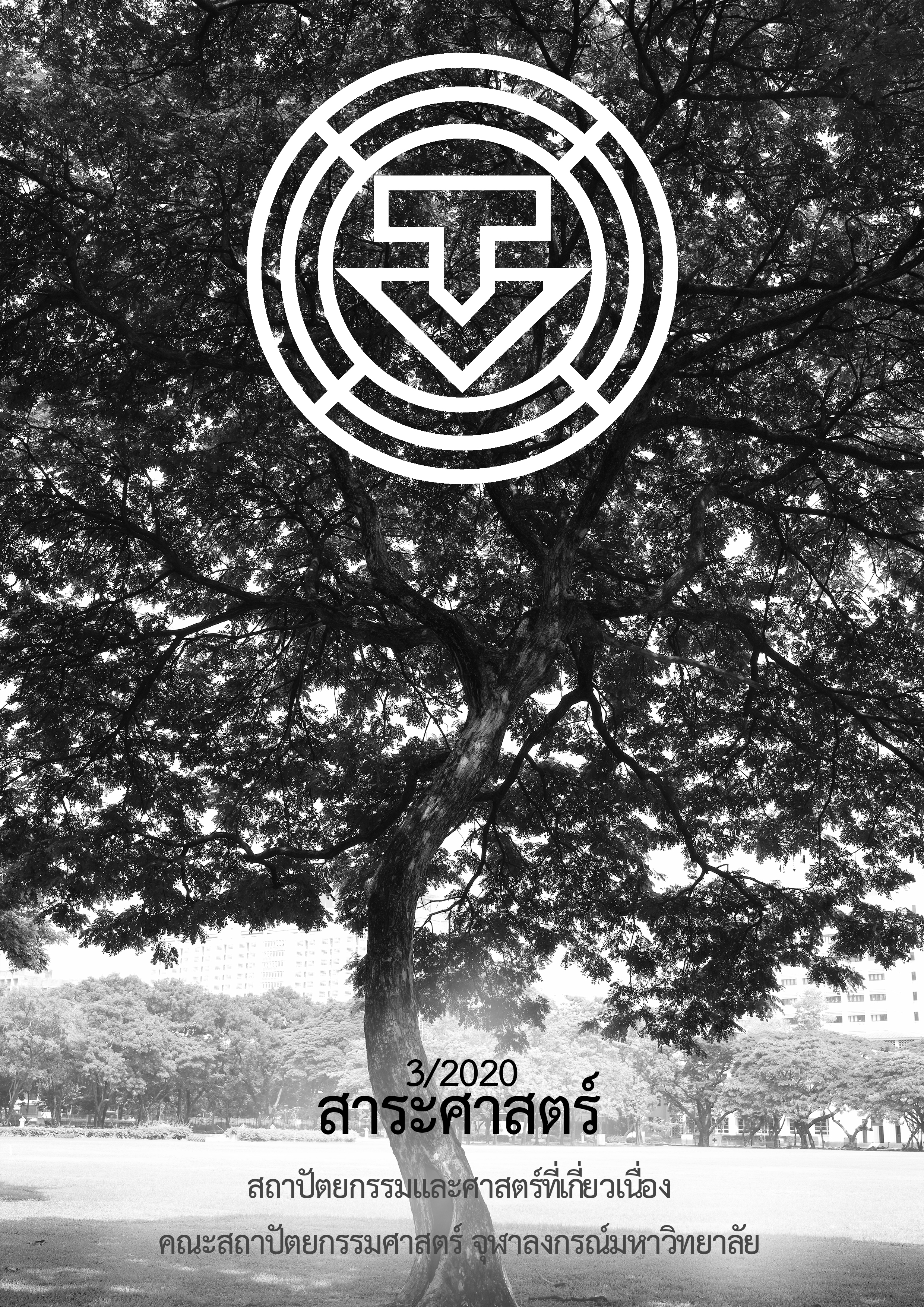ความสัมพันธ์ของการจัดเตรียมที่จอดรถยนต์ในโครงการอาคารชุดและระยะห่างจากโครงการถึงสถานีระบบขนส่งมวลชนแบบเร็วในพื้นที่กรุงเทพมหานคร
Main Article Content
บทคัดย่อ
โครงการอาคารชุดในกรุงเทพมหานครอยู่ภายใต้กฎหมายบังคับใช้กำหนดจำนวนขั้นต่ำของที่จอดรถยนต์ที่ต้องจัดเตรียมในโครงการซึ่งกำหนดจำนวนที่จอดรถยนต์จากขนาดพื้นที่ห้องชุดและพื้นที่อาคาร อย่างไรก็ตามมีงานวิจัยที่กล่าวถึงระยะเดินเท้าของคนที่ชี้ให้เห็นถึงพฤติกรรมการเดินเท้าของผู้พักอาศัยโดยรอบสถานีระบบขนส่งมวลชนแบบเร็วที่ต่างกันไปตามระยะห่างจากสถานี ซึ่งอาจส่งผลถึงความต่างของพฤติกรรมการใช้รถยนต์ของผู้พักอาศัย และการจัดเตรียมจำนวนที่จอดรถยนต์ในโครงการพักอาศัยที่ตั้งอยู่ในระยะห่างจากสถานีที่ต่างกัน งานวิจัยนี้จึงมีจุดประสงค์เพื่อศึกษาการจัดเตรียมที่จอดรถยนต์ของโครงการอาคารชุดในพื้นที่กรุงเทพมหานครเปรียบเทียบกับจำนวนที่จอดรถยนต์ขั้นต่ำตามที่กฎหมายกำหนด และศึกษาความสัมพันธ์ของการจัดเตรียมที่จอดรถยนต์กับระยะห่างจากโครงการอาคารชุดถึงสถานีระบบขนส่งมวลชนแบบเร็ว โดยการศึกษาภาพรวมของโครงการอาคารชุดในกรุงเทพมหานคร คัดเลือกกลุ่มตัวอย่างจำนวน 280 โครงการ ศึกษารายละเอียดข้อมูลโครงการจากรายงานการประเมินผลกระทบสิ่งแวดล้อม (EIA) นำข้อมูลมาจัดการ วิเคราะห์ด้วยวิธีการเชิงสถิติ และสรุปผลการศึกษา
จากการศึกษากลุ่มตัวอย่างพบว่า โครงการอาคารชุดในกรุงเทพมหานครมีสัดส่วนจำนวนที่จอดรถยนต์ที่จัดเตรียมโดยเฉลี่ยอยู่ที่ร้อยละ 105 เมื่อเทียบกับจำนวนที่จอดรถยนต์ขั้นต่ำที่กฎหมายกำหนด มีค่าต่ำที่สุดอยู่ที่ร้อยละ 100 ซึ่งเป็นการจัดเตรียมเท่ากับจำนวนที่จอดรถยนต์ขั้นต่ำที่กฎหมายกำหนด และค่าสูงที่สุดอยู่ที่ร้อยละ 172 ทั้งนี้ โครงการอาคารชุดร้อยละ 80 ของกลุ่มตัวอย่างทั้งหมดจัดเตรียมที่จอดรถยนต์ในโครงการไว้เป็นสัดส่วนไม่เกินค่าเฉลี่ยดังกล่าว
นอกจากนี้พบว่า เมื่อเปรียบเทียบโครงการอาคารชุดกลุ่มตัวอย่างตามระยะห่างของที่ตั้งโครงการจากสถานีระบบขนส่งมวลชนแบบแบ่งช่วงทุกๆ ระยะ 500 เมตร โครงการอาคารชุดที่ตั้งอยู่ห่างจากสถานีระบบขนส่งมวลชนแบบเร็วในระยะ 1,500 - 1,999 เมตรมีการจัดเตรียมที่จอดรถยนต์ไว้มากกว่าค่าเฉลี่ยของกลุ่มตัวอย่างทั้งหมดโดยจัดเตรียมไว้เฉลี่ยอยู่ที่ร้อยละ 110 ในขณะที่โครงการที่อยู่ในระยะใกล้หรือไกลกว่าระยะดังกล่าวจะจัดเตรียมที่จอดรถยนต์ไว้โดยเฉลี่ยเท่ากับหรือใกล้เคียงกับจำนวนขั้นต่ำตามกฎหมาย จากการวิเคราะห์ค่าความสัมพันธ์ด้วยวิธีการหาค่าสัมประสิทธิ์สหสัมพันธสรุปได้ว่า การจัดเตรียมที่จอดรถยนต์ในโครงการอาคารชุดกับระยะห่างจากสถานีระบบขนส่งมวลชนแบบเร็วไม่มีความสัมพันธ์แปรผันตรงกัน โดยมีค่าสัมประสิทธิ์สหสัมพันธอยู่ที่ -0.0055
Article Details
เอกสารอ้างอิง
การรถไฟฟ้าขนส่งมวลชนแห่งประเทศไทย. รายงานประจำปี 2557. กรุงเทพฯ: การรถไฟฟ้าขนส่งมวลชนแห่งประเทศไทย, 2557.
กิตตินันท์ คนขยัน. “ความสัมพันธ์และพฤติกรรมการใช้ที่จอดรถของผู้อยู่อาศัยรายได้น้อยถึงปานกลางในอาคารอยู่อาศัยรวมที่เป็นอาคารขนาดใหญ่: กรณีศึกษา อาคารชุดในเขตกรุงเทพชั้นใน.” วิทยานิพนธ์ปริญญามหาบัณฑิต จุฬาลงกรณ์มหาวิทยาลัย, 2547.
คำแหง ทองอินทร์. “การจัดให้มีที่จอดรถและการใช้พื้นที่จอดรถในโครงการบ้านเอื้ออาทรบึงกุ่ม กรุงเทพมหานคร.” วิทยานิพนธ์ปริญญามหาบัณฑิต จุฬาลงกรณ์มหาวิทยาลัย, 2551.
ชินภัทร ตั้งสุณาวรรณ. “แนวทางกำหนดมาตรการควบคุมจำนวนพื้นที่จอดรถยนต์ ของอาคารชุดพักอาศัยในเขตการให้บริการของระบบขนส่งมวลชนระบบราง.” วิทยานิพนธ์ปริญญามหาบัณฑิต มหาวิทยาลัยธรรมศาสตร์, 2548.
ฉัตรชัย ตั้งมหาสถิตกุล. “สภาพการใช้ที่จอดรถของอาคารชุดพักอาศัยที่เป็นอาคารขนาดใหญ่ในแนวรถไฟฟ้า: กรณีศึกษา อาคารชุดพักอาศัยขนาดใหญ่บนถนนสุขุมวิท.” วิทยานิพนธ์ปริญญามหาบัณฑิต จุฬาลงกรณ์มหาวิทยาลัย, 2553.
ThinkofLiving. “ประเภท segment ของคอนโดมิเนียมและบ้านแนวราบ กับการรีวิวเจาะลึก.” สืบค้น 7 เมษายน 2563. https://thinkofliving.com/article/ประเภท-segment-ของคอนโดมิเนียมและบ้านแนวราบ-กับการรีวิวเจาะลึก-10724-อื่นๆ/เมื่อวันที่ 7 เดือนเมษายน พ.ศ. 2563.
บุญธรรม กิจปรีดาบริสุทธิ์. ระเบียบวิธีการวิจัยทางสังคมศาสตร์. กรุงเทพฯ: สมเจริญพานิชย์, 2535.
พรรณี ศิลปะวัฒนานันท์. เทคนิคการเรียนคณิตศาสตร์ การแปรผัน ชั้นมัธยมศึกษาตอนต้น. กรุงเทพฯ: ฟิสิกส์เซ็นเตอร์, 2553.
พุทธมนต์ รตจีน. “การพัฒนาพื้นที่โดยรอบสถานีขนส่งมวลชน.” วารสารนโยบายการขนส่งและจราจร (2559): 28-31.
วาสนา กลั่นประเสริฐ. “พื้นที่แนวรถไฟฟ้ายังเป็นทางเลือกเอกชนผุดโครงการ.” สืบค้น 18 กุมภาพันธ์ 2563. https://www.prop2morrow.com/2019/02/14/พื้นที่แนวรถไฟฟ้ายังเป/.
ศันสนีย์ แสงศิลา. “พฤติกรรมการเดินเท้าเพื่อเข้ามาใช้งานรถไฟฟ้าของชุมชนรอบสถานีรถไฟฟ้าขนส่งมวลชน.” วิทยานิพนธ์ปริญญามหาบัณฑิต มหาวิทยาลัยศิลปากร, 2555.
สรชัย พิศาลบุตร. การสร้างและประมวลผลข้อมูลจากแบบสอบถาม. กรุงเทพฯ: วิทยพัฒน์, 2556.
สอาด หอมมณี, เกรียงศักดิ์ พินทุสรศรีและบวรวิทย์ เปรื่องวงศ์. “ปัญหาอุปสรรคเกี่ยวกับนิติบุคคลอาคารชุดคอนโดมิเนียม.” วารสารวิชาการศรีปทุม ชลบุรี 15, 2(2561): 70-79.
สำนักงานนโยบายและแผนทรัพยากรธรรมชาติและสิ่งแวดล้อม. “ข้อมูลโครงการที่มีรายงานการประเมินผลกระทบสิ่งแวดล้อม (EIA).” สืบค้น 5 กุมภาพันธ์ 2563. http://eia.onep.go.th/.
สำนักผังเมือง กรุงเทพมหานคร. รายงานการประเมินผลการใช้บังคับกฎกระทรวงให้ใช้บังคับผังเมืองรวมกรุงเทพมหานคร พ.ศ. 2556. กรุงเทพฯ: สำนักผังเมือง กรุงเทพมหานคร, 2556.
สุมาลี ไชยศุภรากุล. ระเบียบวิธีวิจัยทางสังคมศาสตร์. กรุงเทพฯ: เคล็ดไทย, 2558.
อนุเทพ ศิริสิทธิ์. “พฤติกรรมการเดินทางของผู้อยู่อาศัยในอาคารชุดที่ตั้งอยู่ในและนอกระยะการเดินถึงสถานีรถไฟฟ้าสุทธิสาร: กรณีศึกษาโครงการไลฟ์เอทสุทธิสาร ไอวี่รัชดา และรัชดาออร์คิด.” วิทยานิพนธ์ปริญญามหาบัณฑิต จุฬาลงกรณ์มหาวิทยาลัย, 2554.
Barter, P. Parking Policy in Asian Cities. Mandaluyong City: Asian Development Bank, 2011.
Casanova, C., B. R. Celli, P. Barria, A. Casas, C. Cote, J. P. de Torres,…A. Aguirre-Jaime. “The 6-Min Walk Distance in Healthy Subjects: Reference Standards from Seven Countries.” The European Respiratory Journal: Official Journal of the European Society for Clinical Respiratory Physiology 37(2011): 150-156.
City of Costa Mesa. “Residential Parking Regulations - City of Costa Mesa.” Retrieved 2019, November 7. https://www.costamesaca.gov/home/showdocument?id=212.
Guo, Z, and S. Ren. “From Minimum to Maximum: The Impact of Parking Standard Reform on Residential Parking Supply in London from 2004-2010.” Urban Studies 6, 50(2013): 1183–1200.
O’Sullivan, S., and J. Morrall. “Walking Distances to and from Light-Rail Transit Stations.” Transportation Research Record 1, 1538(1996): 19-26.
Ratanawaraha, A., S. Chalermpong and C. Chullabodhi. “Walking Distance of Commuters after Modal Shift to Rail Transit in Bangkok.” Journal of the Eastern Asia Society for Transportation Studies 11(2015): 1467-1478.
Yamane, T. Statistics: An Introductory Analysis. 3rd ed. New York: Harper and Row Publications, 1973.


